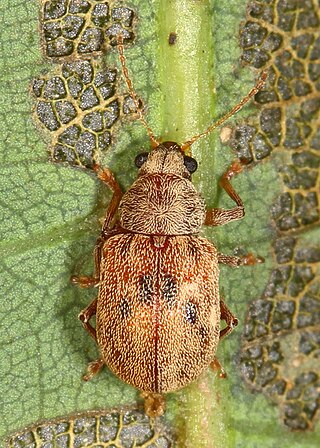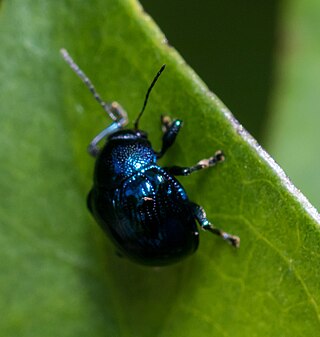
Colasposoma is a genus of leaf beetles in the subfamily Eumolpinae. It is known from Africa, Asia and Australia.

Platycorynus is a genus of leaf beetles in the subfamily Eumolpinae. Species of the genus are found in Africa and Asia.

Colaspoides is a genus of leaf beetles in the subfamily Eumolpinae. It is one of the largest genera in the subfamily, containing over 260 species worldwide. It is an extant genus but there is at least one species, C. eocenicus, found in Baltic amber from the Upper Eocene of Russia, and the genus has also been reported from the Miocene of the Dominican Republic.

Macrocoma is a genus of leaf beetles in the subfamily Eumolpinae. It contains about 100 species, which are found in tropical Africa, around the Mediterranean, on the Canary Islands, in western and central Asia, and in India.

Demotina is a genus of leaf beetles in the subfamily Eumolpinae. There are over 50 described species in Demotina. The genus is native to Asia, Australia and Oceania, though one species is an adventive species in the southeastern United States in North America. Some species are known to be parthenogenetic.

Typophorini is a tribe of leaf beetles in the subfamily Eumolpinae. The tribe contains approximately 100 genera, which are found worldwide. Members of the tribe are mainly characterized by notches on the tibiae of the middle and hind legs, which are sometimes referred to as antenna cleaners. They also generally have a subglabrous body, as well as bifid pretarsal claws.
Hyperaxis is a genus of leaf beetles in the subfamily Eumolpinae. It is distributed in East and Southeast Asia.
Pagria is a genus of leaf beetles in the subfamily Eumolpinae. It is known from Africa, Asia and Australia.
Basilepta is a genus of leaf beetles in the subfamily Eumolpinae. It is generally distributed in Asia. A single species is also known from central Africa.

Cleorina is a genus of leaf beetles in the subfamily Eumolpinae. It is known from Australia and Asia.
Aulexis is a genus of leaf beetles in the subfamily Eumolpinae. It is distributed in East and Southeast Asia. The related genus Goniopleura is sometimes included as a subgenus.
Chrysolampra is a genus of leaf beetles in the subfamily Eumolpinae. It is distributed in Asia and Australia. It is very closely related to Colaspoides, and is possibly a subgenus of it according to L. N. Medvedev (2004).
Cleoporus is a genus of leaf beetles in the subfamily Eumolpinae. It is known from Asia.

Trichochrysea is a genus of leaf beetles in the subfamily Eumolpinae. It is distributed in Asia.
Pseudaoria is a genus of leaf beetles in the subfamily Eumolpinae. It is distributed in East and Southeast Asia. The genus was first established by Martin Jacoby, in a volume of The Fauna of British India posthumously published in 1908, for two newly described species from Manipur and Burma. Pseudaoria is similar to the genus Aoria. In a review of the latter genus in 2012, L.N. Medvedev included Pseudaoria as a subgenus of it.
Nodina is a genus of leaf beetles in the subfamily Eumolpinae. It is distributed in Asia.

Fidia is a genus of leaf beetles in the subfamily Eumolpinae. It is distributed in East Asia, Southeast Asia and Africa.
Callisina is a genus of leaf beetles in the subfamily Eumolpinae. It is distributed in Asia.
Trichotheca is a genus of leaf beetles in the subfamily Eumolpinae. It is distributed in South Asia, Southeast Asia and Southern China.









